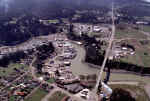 |
Bibliography | Background | Hypotheses | Home |
 |
Bibliography | Background | Hypotheses | Home |
Vegetation Types
![]()
The vegetation and timber types used in KRIS projects were derived from Landsat multi-spectral images taken in 1994. The U.S. Forest Service Pacific Southwest Regional Remote Sensing Lab, in cooperation with the California Department of Forestry, analyzed the Landsat images to formulate a California-wide electronic map layer of vegetation as part of the Northwest Forest Plan (Warbington et al., 1998). The vegetation classification was extensively checked using a number of different methods as described by Warbington et al. (1998):
"Ground-based field observations, existing vegetation samples, aerial photography, digital ortho photography, SPOT imagery and field review of draft maps were all used in validating and correcting classification and modeling errors where observed."
The resolution of Landsat images is about 30 meters and each square in the grid coverage is referred to as a pixel. The USFS vegetation coverage characterizes stand conditions and is not accurate to the pixel level. Stand conditions are accurately represented at the one hectare scale. See Schwind (1999) for a full discussion of methods and how problems such as topographic shading were corrected for. The USFS data is quarried for tree size or community type in KRIS Maps. This allows quantitative assessment of vegetation types for seral stage based on tree size for geographic areas such as Calwater planning watersheds. In the most recent KRIS projects (Navarro, Garcia, Russian, West Marin-Sonoma), data from 1999 were also included along with the 1994 data.
For use in KRIS, one of the simpler vegetation and timber type classifications was chosen with 10 categories. Vegetation classifications are:
| Size Class/Vegetation Type | Diameter of Trees |
| Very Large Trees | 40" in diameter or greater |
| Large Trees | 30-39.9" in diameter |
| Medium/Large Trees | 20-29.9" in diameter |
| Small/Medium Trees | 12-19.9" in diameter |
| Small Trees | 5-11.9" in diameter |
| Saplings | 1- 4.9" in diameter |
| Non-Forest | Non-tree species such as shrubs, grasses or bare soil |
This simpler classification provides an easy to understand index of watershed disturbance for use in coastal watersheds. Large components of early seral stage conditions (Saplings, Non-Forest) are often associated with recent logging disturbance, although upland areas can sometimes be natural grasslands. The vegetation patterns in interior basins, such as the Eel River and Klamath River watersheds, are much more complicated than in coastal ecosystems and more difficult to use to analyze changes in vegetation brought about by watershed management activities.
The KRIS vegetation classification scheme can also be used for a quick analysis of riparian conditions. Ninety meter (297 ft.) zones of riparian influence are assigned to the 1:24000 stream layer in ArcView and only the vegetation within this zone is displayed and analyzed.
![]()
Examples of several seral types and from KRIS Maps.

|
The
city of Fort Bragg is in the Lower Noyo River Basin or Mouth of the Noyo
Calwater unit. Much of the vegetation analysis for this area registers Non-Forest.
Photo by Graham Matthews. 290 KB
|
![]()
Link to the U.S. Forest Service Spatial Analysis Lab and California Department of Forestry's California Land Cover Mapping and Monitoring Program:
http://frap.cdf.ca.gov/projects/land_cover/monitoring/index.html
![]()
References
Fischer, C. 2003. Monitoring Land Cover Changes in California, North Coast Project Area (1994-1998). California Department of Forestry FRAP and USFS Spatial Analysis Lab, Sacramento, CA. http://frap.cdf.ca.gov/projects/land_cover/monitoring/pdfs/nccdp_report_final.pdf
USDA Forest Service Remote Sensing Lab. A machine-learning approach to change detection using multi-scale imagery. CDF FRAP and Pacific Maridian Resources, Sacramento CA.
Schwind, B. 1999. USFS Thematic Mapper Landsat Vegetation Coverage Background Information. USDA Forest Service. Pacific Southwest Region Remote Sensing Lab. Sacramento, CA.
Warbington, R., B. Schwind, C. Curlis and S. Daniel. 1998. Creating a Consistent and Standardized Vegetation Database for Northwest Forest Plan Monitoring in California. USDA Forest Service. Pacific Southwest Region Remote Sensing Lab. Sacramento, CA.
![]()
|
Table of Contents for Background Pages |
|||||
| Stream Conditions: | Water Quality | Sediment | Riparian | Big Wood | Habitat Types |
| Watershed Conditions: | Vegetation Types | Slope Stability | Roads & Erosion | Cumulative Impacts | Urbanization |
| Fish & Aquatic Life: | Fish Populations | Amphibians | Aquatic Insects | Hatcheries | Fish Disease |
| Restoration: | Stream Clearance | In-stream Structures | Riparian | Watershed | Strategy |
| Geology / Hydrology: | Geology | Soils | Precipitation | Stream Flow | Channel Processes |
| Policy & Regulation | ESA | TMDL | Forest Rules | 1603 Permits | Water Rights |
| www.krisweb.com |